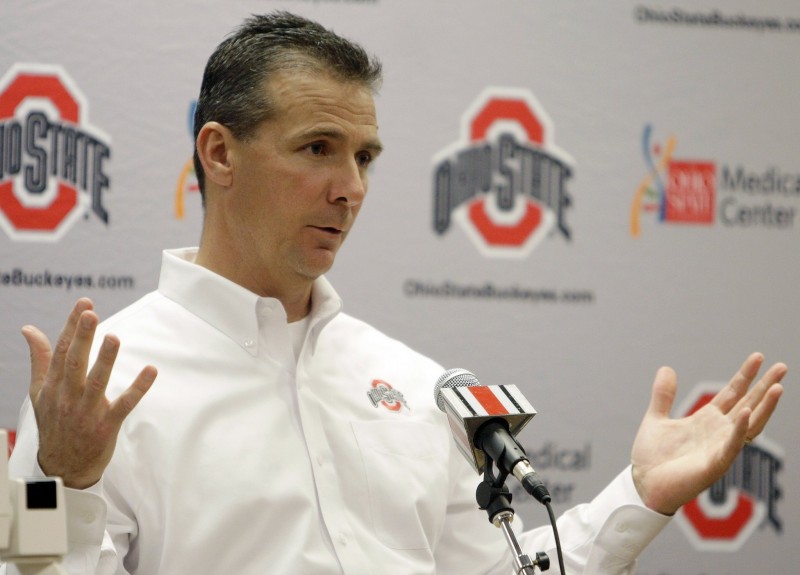COLUMBUS, Ohio — In a Sporting News story published Monday on Ohio State coach Urban Meyer’s tenure at Florida, the program Meyer left winds up sounding a lot like the program he inherited. And none of that should be of particular surprise.
The only problem is for anyone viewing Meyer above or below the spectrum of successful major college football coaches, for good or bad. He’s no more a saint or a sinner than most two-time national championship coaches who recruit at a high level, bring in talent, battle in a super competitive environment like the SEC or Big Ten and have the wins, losses, complaints and praise to go with it.
The Sporting News paints a picture of Meyer catering to his star players over his final years and leaving a roster in Gainesville that led to Florida’s disappointing 7-6 season in the first year under Will Muschamp in 2011.
Jim Tressel’s decision to treat quarterback Terrelle Pryor differently than other players helped lead to the turmoil and NCAA violations that upended the Ohio State program, cost Tressel his job and led to a disappointing 6-7 season in 2011. Meyer has spoken again and again about the talent deficit on the OSU roster he inherited, whether it be at the offensive skill positions, in the offensive line depth, or at linebacker.
That’s kind of how it goes.
New guy comes in, points out the problems, makes comments that either directly or indirectly blame the previous staff, goes about trying to fix them. The difference, and this is a big difference, is that Ohio State’s problems included serious NCAA violations. None of that is alleged in the Sporting News story on Meyer.
In the shadowy world of major college athletics, the difference between those caught breaking major rules and those not caught breaking major rules has to remain a dividing line. There are familiar recruiting questions from Meyer’s entrance into the Big Ten mentioned in the story, but unless Meyer is caught breaking similar rules, keep that in mind.
If players are entitled, or coaches let the best players have a longer leash … that isn’t a unique problem.
The Sporting News also writes of former Florida safety Bryan Thomas, saying he was given a medical hardship to clear a scholarship spot. Running players off is something that absolutely must be monitored, and the Big Ten does that. The new plan with most major schools offering multi-year scholarships is another step toward protecting players from these situations. I have questioned Meyer about his roster management at Ohio State and will continue to keep tabs on the players who leave and the circumstances under which they depart, but Meyer’s reputation in this area is not one of a coach who constantly oversigns at the expense of current players who are following the rules but not producing. Some other SEC coaches have a problem with that.
There is another part of the story in which it is alleged that three Florida stars sat out a season opener with what Meyer called injuries when in fact they were suspended for a failed drug test. I reported years ago that Tressel did the same thing with an OSU player before a bowl game, saying he was hurt when in fact he was suspended.
The story also mentions the number of arrests of Florida players under Meyer, and there were a lot. Too many. Tressel had a run of arrests in his tenure as well before those numbers went down. Certainly the OSU administration was aware of that when Meyer was hired, and it again is a real issue and a number worth monitoring.
The attempt here is only to provide context as readers decide how to interpret the Sporting News story, not to question the story or make excuses for anything that happened at Florida. But a main point of the story is that what happened made the Gators lose games, during and after Meyer left.
Keep in mind that maintaining a high level of success at any program is difficult, even the best ones. Meyer won two national titles in six years, and in year five went 13-1 with his only loss in the SEC title game to eventual champ Alabama. There certainly was a dropoff to 8-5 in Meyer’s final year, after he resigned and then came back to the program for a final season.
Look around.
After reaching the BCS Championship at the end of the 2009 season, Texas has gone 5-7 and 8-5 the last two seasons. If coach Mack Brown would have been forced out or decided to retire, it could have been pointed out how he left a program that had just played for a national title in shambles.
At Florida, basketball coach Billy Donovan, one of Meyer’s best friends, missed the NCAA Tournament two straight years after winning back-to-back national titles in 2006 and 2007. If he had left Gainesville then, the story would have been how he got out when things were down after they’d just been on top.
It’s hard to go out on top. Muschamp didn’t inherit a national championship roster at Florida, just like Meyer didn’t inherit one at Ohio State. But both are great programs, with tradition and talent bases and resources that should allow them to get back on top with good coaching, good leadership and, most importantly, good players.
The coaches will have to bring in that talent and manage it. It’s not always easy. It is always important to do it within the rules. There will be players who love their coaches and players who don’t. The Sporting News story made some points about Meyer’s final years at Florida. They are worthwhile for Ohio State fans to know. But I’m not sure it should change the thinking, or add to the worries, of anyone who had a realistic view of college football, Urban Meyer and Ohio State.

































Discussion about this post